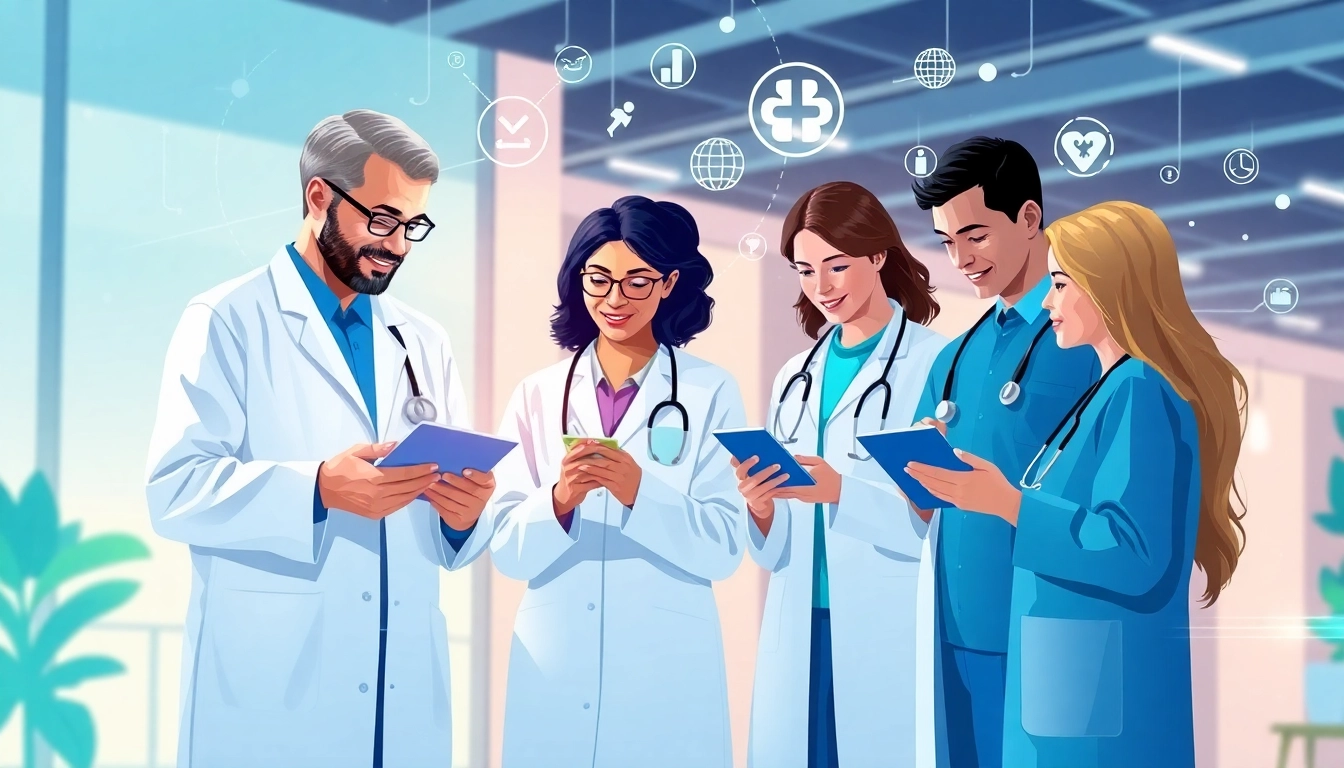Understanding Health Informatics
Health informatics is a multidisciplinary field that merges healthcare, information technology, and communications to improve patient care and enhance the efficiency of healthcare systems. The core objective is to leverage data and technology to transform healthcare delivery. Understanding this domain is pivotal for healthcare providers, researchers, and stakeholders aiming for optimal patient outcomes. To explore more on this vital aspect of healthcare, visit https://www.informaticsview.com.
What is Health Informatics?
Health informatics encompasses the design, development, and application of information systems to manage and analyze health data effectively. By utilizing electronic health records (EHRs), telemedicine objectives, and clinical decision support systems, health informatics presents critical infrastructure enhancements necessary for modern healthcare practices. In essence, it acts as a bridge among healthcare professionals, data, patients, and technology, fostering a community focused on quality and accessible health services.
Key Components of Informatics
The key components of health informatics include:
- Data Management: Efficient storage, retrieval, and management of health information.
- Clinical Decision Support: Systems that provide healthcare professionals with knowledge and patient-specific information to aid in clinical decision-making.
- Telehealth: Remote delivery of healthcare services utilizing technology to connect patients with providers.
- User Interface Design: Creating intuitive and effective systems that physicians and other healthcare providers can use seamlessly.
- Health Information Exchange (HIE): The electronic sharing of health-related information among different organizations while maintaining patient privacy.
The Evolution of Health Informatics
The history of health informatics is interwoven with advancements in technology and the increasing complexity of healthcare systems. Emerging in the 1960s as computers began to be adopted in research and hospital settings, the field has evolved tremendously. Key milestones include:
- 1960s-1970s: Initial explorations into using computers for patient records.
- 1980s: Development of the first EHRs that integrated data from various clinical units.
- 1990s: Growth of standards for data exchange among healthcare providers.
- 2000s: Increasing adoption of HIE, telemedicine, and integrated healthcare technologies.
- 2010s-Present: Accelerated implementation of AI and machine learning in predictive analytics for patient treatment.
Applications of Informatics in Healthcare
Electronic Health Records and Their Importance
Electronic Health Records (EHRs) have transformed the way healthcare information is tracked and shared. EHRs serve as comprehensive digital versions of patients’ paper charts, enabling real-time information sharing and facilitating more coordinated and efficient care. The importance of EHRs lies in their ability to:
- Enhance Patient Care: By providing complete and up-to-date information to clinicians at the point of care.
- Facilitate Data Sharing: Through interoperability among different healthcare providers, promoting a holistic view of patient health.
- Minimize Errors: By reducing reliance on paper records, which can be lost or misread.
- Improve Efficiency: Streamlining processes and reducing administrative burdens through automated documentation and billing processes.
Clinical Decision Support Systems Explained
Clinical Decision Support Systems (CDSS) are integral to the contemporary healthcare ecosystem, designed to assist healthcare providers in making informed decisions about patient care. These systems analyze and interpret clinical data, providing actionable insights to physicians. CDSS can:
- Improve Diagnostic Accuracy: By offering evidence-based recommendations based on aggregated clinical data.
- Promote Compliance: Assist healthcare workers in adhering to clinical guidelines and ensuring best practices.
- Enhance Treatment Options: Provide alternative treatment strategies derived from vast medical knowledge and patient data.
Telemedicine: Bridging the Gap in Patient Care
Telemedicine is revolutionizing healthcare by allowing patients to receive care remotely, particularly beneficial in underserved areas. It leverages telecommunications technology to provide clinical services without requiring in-person visits.
The advantages of telemedicine include:
- Increased Accessibility: Patients can consult specialists without geographical constraints.
- Cost-Effectiveness: Reducing overhead travel and facility costs for both patients and providers.
- Improved Monitoring: For chronic disease management through real-time data sharing and communication.
Challenges in Implementing Health Informatics
Privacy and Data Security Concerns
With the digital transformation of healthcare, privacy and data security have become paramount. The sensitive nature of health data necessitates robust protective measures to prevent unauthorized access and data breaches. Key aspects include:
- Regulatory Compliance: Ensuring adherence to HIPAA and other regulations governing health information confidentiality.
- Data Encryption: Safeguarding patient data at rest and during transmission.
- Employee Training: Regular training on data security protocols for all staff members handling sensitive information.
Interoperability Issues in Healthcare Systems
Interoperability remains a significant barrier in health informatics. The ability of various information systems to communicate and exchange data effectively is essential for a seamless healthcare experience. Challenges include:
- Diverse Standards: The existence of varied data formats and standards among different health IT systems inhibits integration.
- Legacy Systems: Older systems often do not support modern interoperability standards, creating siloed information.
- Lack of Incentives: Providers may lack motivation to invest in systems that promote interoperability.
Resistance to Technological Change
The adoption of informatics solutions can encounter resistance from healthcare professionals due to fears of technology obsolescence and a steep learning curve. Strategies to reduce resistance include:
- Stakeholder Engagement: Involving healthcare professionals in the decision-making process and selection of systems to enhance buy-in.
- User-Friendly Interfaces: Focusing on designing interfaces that are intuitive and reduce learning time.
- Continuous Support and Education: Providing ongoing training and resources for staff to improve confidence in using new technologies.
Best Practices for Effective Informatics Integration
Training Healthcare Professionals in Informatics
Effective integration of health informatics necessitates that healthcare providers receive comprehensive training in using informatics tools. This includes:
- Curriculum Development: Creating educational programs that focus on the practical application of informatics in clinical settings.
- Hands-On Training: Implementation of simulation exercises where healthcare professionals can practice informatics tasks in a controlled environment.
- Mentorship Programs: Pairing less experienced staff with informatics-savvy mentors to facilitate learning and confidence.
Leveraging Patient Engagement Tools
Engaging patients in their own healthcare journey is fundamental, and patient engagement tools serve as essential instruments to facilitate this relationship.
Key benefits of employing these tools include:
- Enhanced Communication: Allowing for real-time information sharing between patients and clinicians.
- Increased Adherence: Encouraging patients to follow treatment plans and remember appointments through reminders and feedback tools.
- Personalized Care: Facilitating tailored health interventions based on individual patients’ needs and preferences.
Establishing Robust Data Governance Frameworks
The success of health informatics heavily relies on how data is managed. Establishing a governance framework can guide the effective use and security of patient information. Key components of data governance include:
- Data Quality Standards: Ensuring that data entering systems is accurate, relevant, and timely.
- Access Control: Defining roles and privileges regarding who can access data and under what conditions.
- Regular Audits: Conducting regular reviews of data handling practices to ensure compliance with established guidelines.
The Future of Health Informatics
Emerging Technologies and Their Impact
The future of health informatics is poised at the intersection of new technological innovations and healthcare delivery systems. Emerging technologies such as blockchain, the Internet of Things (IoT), and advanced analytics are expected to bring significant transformations. The implications of such technologies include:
- Blockchain: Enhancing the security and integrity of patient data through decentralized databases that are harder to manipulate.
- IoT Devices: Allowing for continuous monitoring of patient health metrics through wearable devices that feed data into healthcare systems.
- Big Data Analytics: Harnessing vast amounts of healthcare data to predict trends, improve diagnostics, and personalize treatment plans effectively.
The Role of AI in Informatics
Artificial intelligence (AI) is revolutionizing health informatics by automating mundane tasks and providing deeper insights through data analysis. The applications of AI in healthcare include:
- Predictive Analytics: Using historical data to predict future patient outcomes and enhancing proactive care.
- Chatbots: Delivering support and answering patient inquiries to reduce workloads for healthcare professionals.
- Imaging Analysis: AI algorithms capable of interpreting medical imaging more quickly and accurately than human radiologists.
Predictions for the Next Decade in Healthcare Technology
The next decade in healthcare technology promises to bring enhanced collaboration between technology and medical professionals, driving an era of precision health. Predictions include:
- Widespread Telehealth Adoption: Continued investment in telehealth infrastructure, leading to broader acceptance among healthcare professionals and patients.
- Holistic Health Records: The integration of social, economic, and environmental data into EHRs, fostering a more comprehensive understanding of patient health.
- Personalized Medicine: A shift towards customized treatment plans that leverage genetic information and lifestyle data to optimize patient outcomes.



